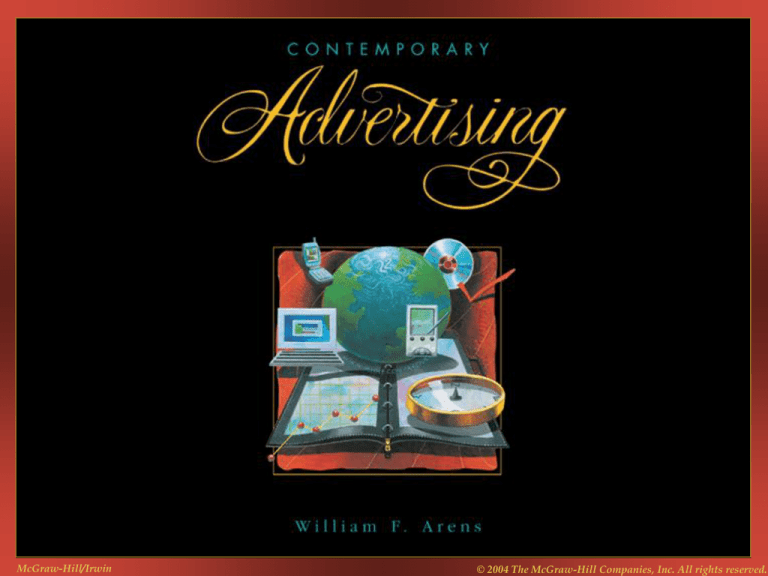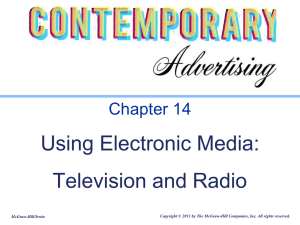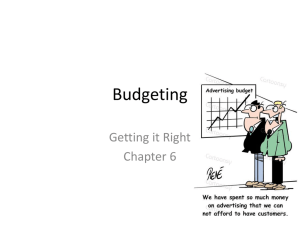
McGraw-Hill/Irwin
© 2004 The McGraw-Hill Companies, Inc. All rights reserved.
Chapter 16
Using Electronic Media: Television
and Radio
Presents the important factors
advertisers need to evaluate
when considering the use of
radio and television in the
creative mix
Objectives
Describe advantages and
drawbacks of broadcast
TV as an ad medium
Explain the process of
buying cable and
broadcast TV time
Discuss advantages and
drawbacks of cable TV
as an ad medium
Evaluate the different
types of TV advertising
Describe the process of
TV audience
measurement
Discuss the main factors
when buying TV time
Analyze the pros and
cons of using radio in the
creative mix
Explain the major factors
to consider when buying
radio time
The Medium of Television
Broadcast TV
VHF
UHF
Cable TV
TV audience trends
Use of television in IMC
Types of TV Advertising
Network advertising
Sponsorship
Syndication
Participation
Off-network
Spot
announcements
First-run
Barter
Program-Length
Ads
Types of TV Advertising
Network advertising
Local TV advertising
Pros and Cons of Broadcast TV
Advertising
Pros
Mass coverage
Creativity
Low cost
Prestige
Some selectivity
Social dominance
Impact
Pros and Cons of Broadcast TV
Advertising
Cons
Brevity
High production cost
Clutter
High air-time cost
Zipping and zapping
Limited selectivity
perception,
Exchanges
TV Audience
Measurement
satisfaction
Rating services: The book
Neilsen
SMRB
Mediamark
Cable ratings
Defining television markets
Designated market
areas (DMAs)
perception,
Exchanges
TV Audience
Measurement
satisfaction
Dayparts
Daytime 9 A.M. – 4 P.M (EST)
Combine
as early
fringe
Early fringe 4 – 5:30 P.M. (EST)
Early news 5 or 5:30 – 7:30 P.M. (EST)
Prime access 7:30 – 8 P.M. (EST)
Prime: 8 – 11 P.M. (EST)
Combine
as late
fringe
Late news: 11 – 11:30 P.M. (EST)
Late fringe: 11:30-1 A.M. (EST)
perception,
Exchanges
TV Audience
Measurement
satisfaction
Dayparts
Audience measures
TV households
(TVHH)
Households using TV
(HUT)
Program rating
Rating = TVHH tuned to a specific program
Total TVHH in area
perception,
Exchanges
TV Audience
Measurement
satisfaction
Dayparts
Audience measures
Gross Rating Points (GRPs)
Gross rating points =
Reach (average rating) x Frequency
perception,
Exchanges
Buying
Television Time
satisfaction
Requesting avails
Selecting programs for buys
Media buyer selects the most
efficient program
Cost per point (CPP):
CPP = Cost / Rating
Cost per thousand (CPM):
Cost / Thousands of people
perception,
Exchanges
Buying
Television Time
satisfaction
Requesting avails
Selecting programs for buys
Negotiating prices and
contracts
Preemption rate
Affidavit of performance
Makegoods
perception,
Exchanges
Buying
Television Time
satisfaction
Requesting avails
Selecting programs for buys
Negotiating prices and
contracts
Electronic media buying
software
Other Forms of Television
DBS beams
programs from
space via
satellite
MDS: microwave delivery
system
STV: over-the-air
Pay TV
SMATV uses a satellite dish to
capture signals
The Medium of Radio
Who uses radio?
The use of radio in IMC
Imagery Transfer
Radio programming and
audiences
The Medium of Radio
Radio programming and
audiences
Programming formats
Buying Radio Time
Types of radio advertising
Networks
Local radio
Spot radio
Radio Terminology
Dayparts
Gross rating points
Buying Radio Time
Types of radio advertising
Radio Terminology
6am-10am
Morning drive
10am-3pm
Daytime
3pm-7pm
Afternoon drive
7pm-midnight Nighttime
Midnight-6am All night
Buying Radio Time
Radio Terminology
Average Quarter-Hour
Audience
Average Quarter-Hour
Rating
AQH persons
X 100
Population
Average Quarter-Hour
Share
AQH persons of a station
X 100
AQH persons of all stations
Gross Rating Points
Cume Estimates
Gross impressions
Population
X 100
Seven Steps in Preparing a Radio
Schedule
1. Identify stations with the greatest
concentration of the target audience
2. Identify stations whose format offers
the highest concentration of potential
buyers
Seven Steps in Preparing a Radio
Schedule
3. Determine which dayparts on those
stations offer the most potential buyers
4. Construct a schedule with a strong
mix of the best time periods
Seven Steps in Preparing a Radio
Schedule
5. Assess the proposed buy in
terms of reach and frequency
6. Determine the cost of the target
audience
7. Negotiate and place
the buy












